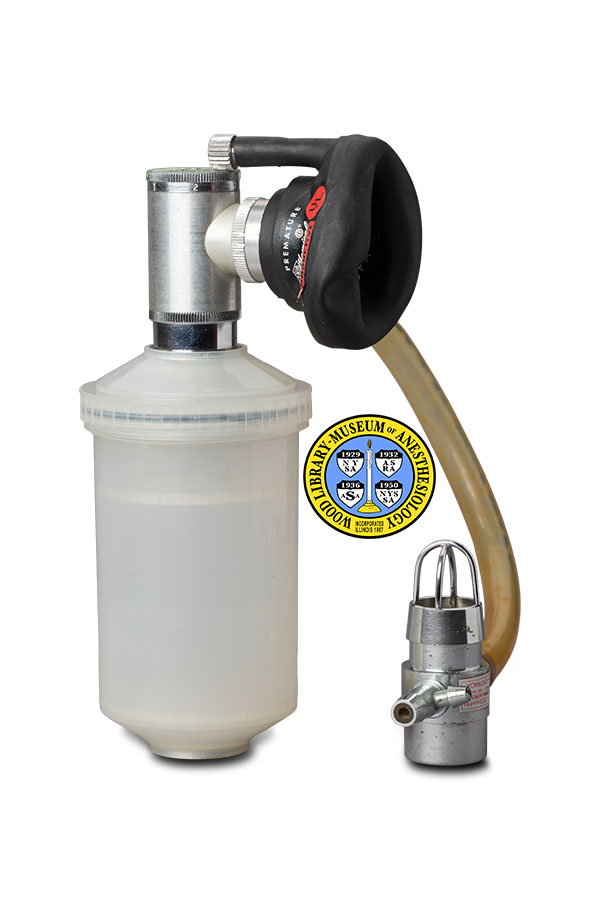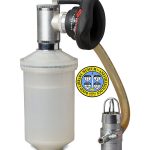Takaoka Infant Circle Absorber
Closed-circuit anesthesia allows the patient to rebreathe his own exhaled gases by absorbing carbon dioxide (CO2), and adding oxygen. This permits safer and more efficient delivery of inhaled anesthetics than was possible with older masks and inhalers. Modern CO2 absorbers were introduced in 1924, but at first even the smallest of them was too large for infants and young children. In the 1940s, advances in pediatric surgery and instrumentation led to the introduction of absorbers made just for these patients.
The anesthesiologist and inventor, Kentaro Takaoka, M.D., was born in 1919, in Saõ Paulo, Brazil. In 1957, he founded a company to produce the portable respirator that he had designed. K. Takaoka Industria e Comércio Ltda. grew to manufacture many types of anesthesia equipment. In 1966, Dr. Takaoka designed a new CO2 absorber suitable for both adults and children. In 1971, he obtained a U S. patent for the infant model shown here. When in use, the valve at the end opposite to the mask would be inserted in a rubber rebreathing bag.
Catalog Record: Takaoka Infant Circle Absorber
Access Key: amyf
Accession No.: 2015-06-12-2
Title: [Takaoka infant circle absorber.]
Author: Takaoka, Kentaro, born 1919.
Title variation: Alt Title
Title: Takaoka carbon dioxide absorber.
Title variation: Alt Title
Title: Takaoka rebreathing apparatus for anesthesia.
Publisher: Saõ Paulo, Brazil : K. Takaoka Industria e Comércio Ltda., [between 1968 and 1991?].
Physical Descript: 1 absorber : plastics, metals, rubber ; 9 x 13 x 24 cm.
Subject: Anesthesia, Inhalation – instrumentation.
Subject: Anesthesia, Pediatric – instrumentation.
Subject: Anesthesia, Closed-Circuit.
Subject: Carbon Dioxide Absorbers.
Note Type: General
Notes: The absorber is described from the point of view of the patient.
The first year in the date range is based on the date of the earliest
published reference to the apparatus that was found by tne cataloger. The
second year in the date range is based on the date of a Takaoka product
brochure that includes absorbers, but not this absorber.
Although an undated Takaoka brochure describes this as a “to and fro
absorber”, Holm and Secher (1968), and the patent (1971) both state that it
differs in important respects from a to-and-fro apparatus.
Note Type: Citation
Notes: Aldrete JA. Original contributions of Latin-Americans to anesthesia. Bull
Anesth Hist. April, 2002;20(2):1,4-11.
Note Type: Citation
Notes: Biblioteca do Departamento per imagem da Universidade Federal de Saõ Paulo
website. https://bibliotecaddiunifesp.blogspot.
com/2012/09/revista-conta-historia-do-medico.html. Accessed May 9, 2016.
Note Type: Citation
Notes: The Foregger Company. Catalog No. 9. New York, NY: The Foregger Company;
1949.
Note Type: Citation
Notes: Holm HH, Secher O. A new circle system for paediatric anaesthesia. Acta
Anaesthiologica Scandinavica. 1968;12(2):81-88.
Note Type: Citation
Notes: Lundy JS. Clinical Anesthesia: A Manual of Clinical Anesthesiology.
Philadelphia: Saunders, 1942:304.
Note Type: Citation
Notes: Morris LE. The circulator concept. Intl Anesth Clinics. Fall,
1974;12(3):181-198.
Note Type: Citation
Notes: Takaoka K. Novo circuito avalvular e com circulacoa de gases [Miscelania].
Braz J Anesthesiol. October-December, 1968;18(4):478-482.
Note Type: Citation
Notes: Takaoka K, inventor. Rebreathing apparatus for anesthesia. US patent 3,612,
048. October 12, 1971.
Note Type: Citation
Notes: Takaoka, Ltda. Equipamentos de Anestesia. Saõ. Paulo, Brazil: Takaoka, Ltda.,
November, 1991. Archives. Located at: Wood Library-Museum of Anesthesiology,
Schaumburg, Illinois.
Note Type: Citation
Notes: Takaoka, Ltda. New To and Fro Absorber with Circulation for pediatric
anesthesia. Takaoka. Ltda. S. Paulo, Brazil: Takaoka, Ltda., date unknown.
Archives. Located at: Wood Library-Museum of Anesthesiology, Schaumburg,
Illinois.
Note Type: Citation
Notes: Venturini AH. A history of anesthesia in South America. In: Eger EI, 2nd.,
Saidman LJ, Westhorpe RN, eds. The Wondrous Story of Anaesthesia. New York:
Springer, 2014.
Note Type: Physical Description
Notes: One absorber; Consists of a canister with a removable valve inserted at each
end, and a tube that connects these valves to one another; The translucent
plastic canister has a screw-on cap; The canister is 12 centimeters in depth
and 7 centimeters wide; The side of the canister is marked with the
manufacturer’s logo; The interior of the cap is fitted with a rubber gasket
and a metal spring that holds a plastic disc; The disc is 5 centimeters in
diameter, and is pierced with small holes throughout its surface;
In the center of the cap, an opening (approximately 2 centimeters in
diameter) is fitted with a metal ring that holds a removable metal breathing
valve (described in the patent as a “circulation tube”); The cap of this
valve is pierced with several holes; The rim of this cap can be turned to
left or right; The rim is striated to provide texture for gripping, and is
engraved with the numbers: “0, 1, 2, 3, 4, 5”; Immediately below the rim, a
red dot is painted on the side of the valve; When one of the numbers on the
rim is aligned with this mark, it indicates the selected setting;
This breathing valve has a lateral extension (described in the patent as a
“mask elbow”), to which a black rubber mask is fitted; The mask is marked:
“Conductive”, followed by an elongated diamond (which might represent the
logo of either the Ohio Company or Medical and Industrial Equipment, Ltd.),
and a mark which might be the number “1”; Set at a right angle to the “elbow”
the valve has a connecting port that is approximately 2 centimeters long;
Near the end opposite to the cap, the interior of the canister is fitted with
another disc of pierced plastic; This disc is held in place by adhesive; In
the center of the bottom of the canister an opening (approximately 3
centimeters in diameter) is fitted with a metal ring that holds a removable
metal valve (described in the patent as a “gas inlet”); This is marked “2L.
/Min. [new line] 120 mmHg [new line] K. Takaoka [new line] ind. brasil. pat.
requer. [new line] Saida [arrow pointing left] Entrada”;
This inlet valve has two lateral connecting ports, which are set directly
opposite to one another; One of these ports is approximately 2 centimeters
long; The other port is 3 centimeters long, and has a secondary lateral port,
approximately 1centimeter long, set at a right angle; The end of the inlet
valve which is opposite to the canister holds two crossed struts that form a
cage approximately 2 centimeters long; This end of the valve is intended to
hold a rubber rebreathing bag (missing from this example);
A translucent, yellow plastic tube is attached at one end to the short,
lateral port on the breathing valve, and at the other end to shorter of the
two lateral ports on the inlet valve; This tube is approximately 25
centimeters long.
Note Type: Reproduction
Notes: Photographed by Mr. Steve Donich, January 11, 2016.
Note Type: Acquisition
Notes: Gift of the Guedel Memorial Anesthesia Center (GMAC), San Francisco, CA.
Note Type: Historical
Notes: Closed-circuit anesthesia allows the patient to rebreathe his own air by
absorbing carbon dioxide (CO2) from the exhaled gases, and adding oxygen.
This permits safer and more efficient delivery of inhaled anesthetics than
was possible with older masks and inhalers. Modern CO2 absorbers were
introduced in 1924, but at first even the smallest of them was too large for
infants and young children. In the 1940s, advances in pediatric surgery led
to the introduction of absorbers made just for these patients.
The anesthesiologist and inventor, Kentaro Takaoka, M.D. was born in 1919, in
Saô Paulo, Brazil. In 1957, he founded a company to produce the portable
respirator that he had designed. K. Takaoka Industria e Comércio Ltda. grew
to manufacture many types of anesthesia equipment. In 1966, Dr. Takaoka
designed a new CO2 absorber suitable for both adults and children. In 1971,
he obtained a U S. patent for the infant model shown here. When in use, the
valve at the end opposite to the mask would be inserted in a rubber
rebreathing bag.
Note Type: Provenance
Notes: The donor (GMAC) associated this object with the late William B. Neff, M.D.
It is likely that it was given to GMAC by Dr. Neff, who served on the GMAC
Board of Trustees. and who himself designed a infant circle absorber.
Note Type: Exhibition
Notes: Selected for the WLM website (noted January 4, 2016).


